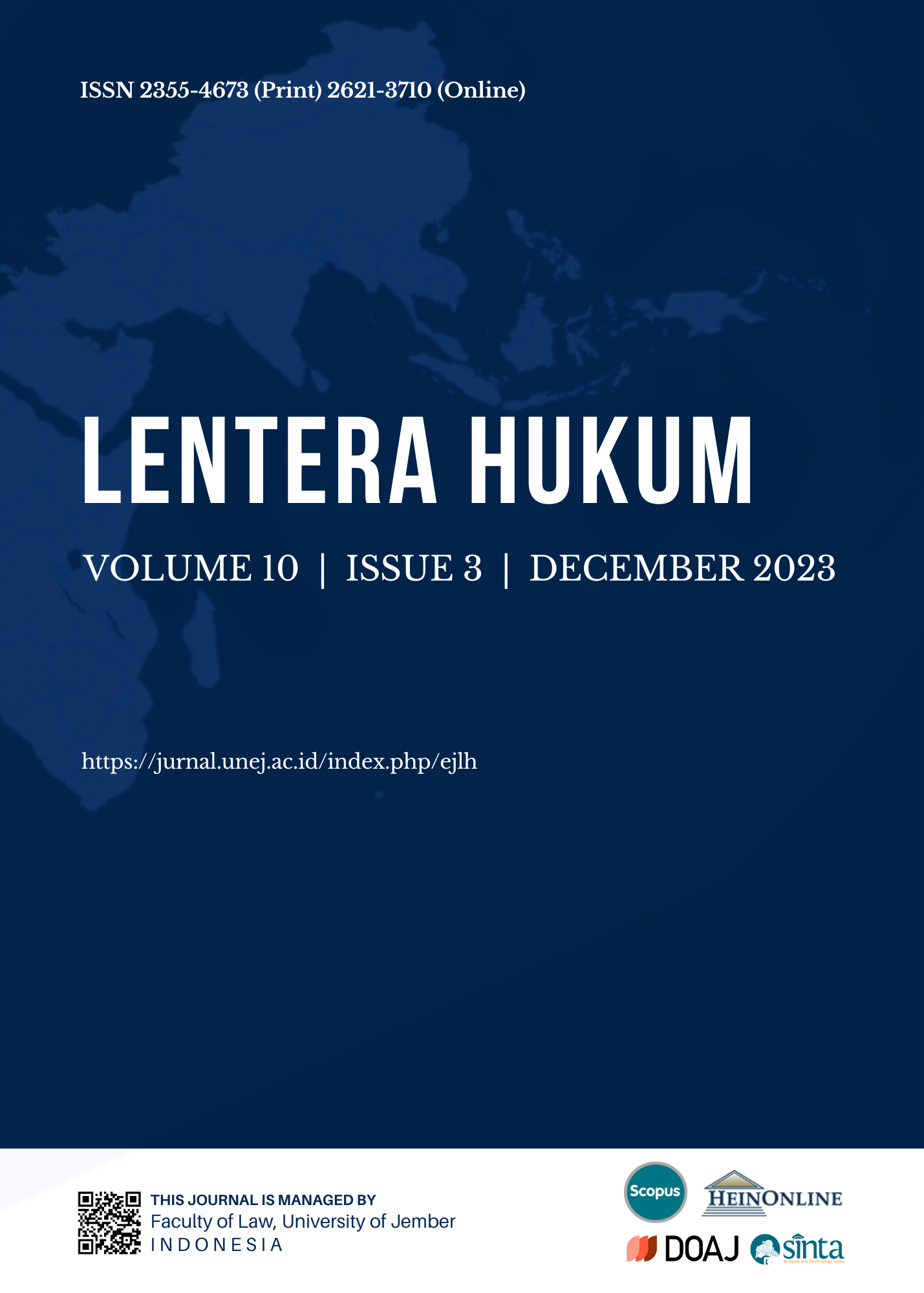Exploring Efficacy
A Study of Simple and Complex Approaches to Divorce Mediation in Indonesian Religious Courts
Abstract
The rising global divorce rate is reshaping the landscape of family dispute resolution, moving away from the adversarial or litigation system toward an alternative dispute resolution known as mediation. This global trend is also observed in Indonesia where the Supreme Court has mandated the use of mediation in civil cases. "Everybody wins, nobody loses" as the primary slogan of mediation emphasizes a win-win outcome for all parties involved, avoiding any losers. However, assessing its efficacy in handling divorce cases in Indonesia becomes crucial. This is mainly because the settlement rate has been discovered to be low in Indonesia since the mandatory implementation of court-annexed mediation for almost two decades compared to other countries such as Australia and the United States. In both countries, settlement is not only based on agreements but also on the process that satisfies the parties. Therefore, this study aims to examine the conceptual issues underlying the low effectiveness of divorce mediation by questioning agreements as a measure of divorce mediation effectiveness. This study uses the sociolegal framework to critique the Supreme Court Regulation 1/2016 regarding Mediation in court and its dynamics in divorce cases. Moreover, courtroom study is applied to observe the mediation process. The results showed that the success of mediation revolves around the number of agreements reached by the parties and the process did not focus on the characteristics of divorce cases, thereby considered not suitable for all cases. Furthermore, the court-annexed mediation regulation creates ambiguity between the use of marital mediation to reconcile the parties and divorce mediation to proceed post-divorce agreement or both.
Keywords: Effectiveness of Mediation, Divorce Mediation, Religious Courts.
References
Bercovitch, J, International Dispute Mediation: A Comparative Empirical Analysis in K Kressel D.G (San Fransisco: Pruitt, & Associates, Mediation Research, 1989) 241-262.
Boardman, SK, “Practice note: Marital Mediation: A psychological Perspective” (2013) 31:1 Conflict Resolution Quarterly 99–108.
Boyle, Alysoun, “Effectiveness in Mediation: A New Approach” (2017) 12 The Newcastle Law Review 148–161.
Cahyadi, Antonius & Sulistyowati Irianto, Runtuhnya Sekat Perdata dan Pidana: Studi Peralihan Kasus Kekerasan terhadap Perempuan (Jakarta: Yayasan Obor Indonesia, 2008).
Cammack, Mark E, Islamic Law in Contemporary Indonesia Ideal and Institution, R.Michael Feener, ed (Cambridge: Harvard University Press, 2007).
Carnevale, PJD, RG Lim & M McLaughlin, Contingent Mediator Behaviour and Its Effectiveness, in K Kressel D.G (San Fransisco: Pruitt, & Associates, Mediation Research).
Creo, RA, “Failure & Me” (2012) 30:10 Alternatives 187–188.
Emery, Robert E, Renegotiating Family Relationship: Divorce, Child Custody, and Mediation, second ed (New York: Routledge, 2012).
Emery, RE, D Sbarra & T Grover, “Divorce Mediation: Research and Reflections” (2005) 43:1 Family Court Review 22–37.
Fauzi, Faisal Rahmat, Efektifitas Mediasi dalam Penyelesaian Sengketa Perceraian (Studi di Pengadilan Agama BukitTinggi dan Pengadilan Agama Payakumbuh Tahun 2015-2017.
Folberg, J & A Taylor, Mediation: A Comprehensive Guide to Resolving Conflicts...p.4.
Geoffrey, J, “Favaloro, Mediation: A Family Therapy Technique?” (1998) 16:1 Mediation Quarterly 101–108.
Golberg, F, Sander & NH Rogers, Dispute Resolution: Negotiation, Mediation, and Other Process (Boston, Toronto: Little Brown and Company, 1992).
Gottman, JM, “Gottman method couple therapy” (2008) 4:8 Clinical Handbook of Couple Therapy 138–164.
Gross, AE, Is Agreement the Gold Standard for Mediation Success? (2017).
Hiltrop, JM, “Factors Associated with Successful Labour Mediation” in KKressel DG Pruitt & Associates, eds, Mediation Research (San Fransisco: Jossey-Bass, 1989) 241.
Hughes, Patricia, “Mandatory Mediation: Opportunity or Subversion (19 Windsor Y.B. Access Just.161 Year 2001)” (2001).
Huis, Stijn van, “Rethinking the Implementation of Child Support Decisions -Post-divorce Rights and Access to the Islamic Court in Cianjur, Indonesia” 2010:1 Law, Social Justice & Global Development Journal (LGD, online:
Husa, J, A New Introduction to Comparative Law (Oxford: Bloomsbury Publishing, 2015).
Huwelijksordonnantie. S. 1929 No. 348 jo. S. 1931 No. 467, Vorstenlandsche Huwelijksordonnantie S. 1933 No. 98 dan Huwelijksordonnantie Buitengewesten S. 1932 No. 482.
Kelly, JB, “Mediation and Psychotherapy: Distinguishing the Differences” (1983) 1 Mediation Quarterly 33–44.
Marriot, Arthur, “The Role of ADR in the Settlement of Commercial Disputes” (1994) 1 Asia Pacific Law Review 1–19.
Mayer, Bernie, “Mediation: 50 Years of Creative Conflict” (2013) 51:1 Family Court Review 34–41.
Moore, CW, The Mediation Process: Practical Strategies for Resolving Conflict, 4th ed (San Francisco: Jossey-Bass Publishers, 2014).
Muhammad, Abdul Kadir, Hukum Perdata Indonesia (Bandung: Citra Aditya Bakti, 2000).
Notohamidjoyo, O, “Demi Keadilan dan Kemanusiaan: Beberapa Bab dari Filsafat Hukum” (1975) 12:2 Kertha Wicaksana 145–155.
Nur, M, Mediasi Keluarga dan Tantangannya Bagi Pengadilan Agama (2019).
Nur, M, “Mengkualifikasi Keabsahan Kesepakatan Perdamaian Sebagian Pihak” in Majalah Peradilan Agama, Edisi 6 (Mei, 2015) 27.
Pruitt, Dean G & RS Pierce, “Long Term Success in Mediation, Law and Human Behaviour” (1993) 17:3.
Putro, Widodo Dwi, Kritik Terhadap Paradigma Positivisme Hukum (Yogyakarta: Genta Publishing, 2011).
Ross, W, “Measuring Success in Mediation” (2000) 1:1 The Mediatio Journal 1–16.
Saifullah, M, “Efektivitas Mediasi dalam Penyelesaian Perkara Perceraian di Pengadilan Agama Jawa Tengah” (2015) 25:2 Al Hakam 193.
Sandu, C, "Mediation. Measuring the Success of Mediation. Conflict Studies" (2013) Quarterly 30–39.
Saposnek, DT, “The Art of Family Mediation” (1993) 11:1 Mediation Quarterly 5–12.
Seth, Reva, Mediation: The Great Equalizer? A Critical Theory Analysis (2000).
Sumner, C & T Lindsey, “Courting Reform: Indonesia’s Islamic Courts and Justice for the Poor” (2011) 4:1 International Journal for Court Administration 3–16.
Wirdyaningsih, Mediasi Sebagai Upaya Mewujudkan Ishlah dalam Penyelesaian Sengketa Perbankan Syariah (Yayasan Pengkajian Hadits el-Bukhori, 2018).
Widiana, Wahyu, Upaya Penyelesaian Perkara Melalui Perdamaian di Pengadilan Agama, Kaitannya dengan BP4.
Zubek, JM, Pruitt DG & Peirce RS, “Disputant and Mediator Behaviours Affecting Short Term Success in Mediation” (1992) 36 Journal of Conflict Resolution 546–572.

This work is licensed under a Creative Commons Attribution-ShareAlike 4.0 International License.




